As per the tale in Aztec mythology, Axolotl is the Aztec’s God of fire and lightning, the Xolotl. He escaped from a sacrifice and at last exiled into such form from his brother. These amphibians from Mexico are very much impressive as they can regenerate their lost limbs, any organ, even parts of the brain, and can stay young throughout their life.
Why is axolotl so much different from every other vertebrate? What is unusual about their physiology that makes them the most important amphibian known till now to science? Here are the answers.
Axolotl, the spirit of god

In Aztec mythology, the tale of five suns is conveyed as the creation myth of this world. In that tale, the rise of the fifth sun fetched an era in which humans were created. The fifth sun was not movable in the sky as it needs the nourishment of a sacrifice. Gods themselves were the first to be sacrificed.
Xolotl was the god of fire and lightning, who got changed to other forms, firstly to maize plant(Xolotl), then to agave plant (mexolotl), and lastly to water beast, the Axolotl as he did not want to get sacrificed. His brother later found him and disguised him to live forever as an Axolotl. This water beast still believes to hold the spirit of god. Scientifically also this creature is amazing as it can regenerate lost limbs, body parts, and even brain parts.
Habitat: Where Axolotl lives
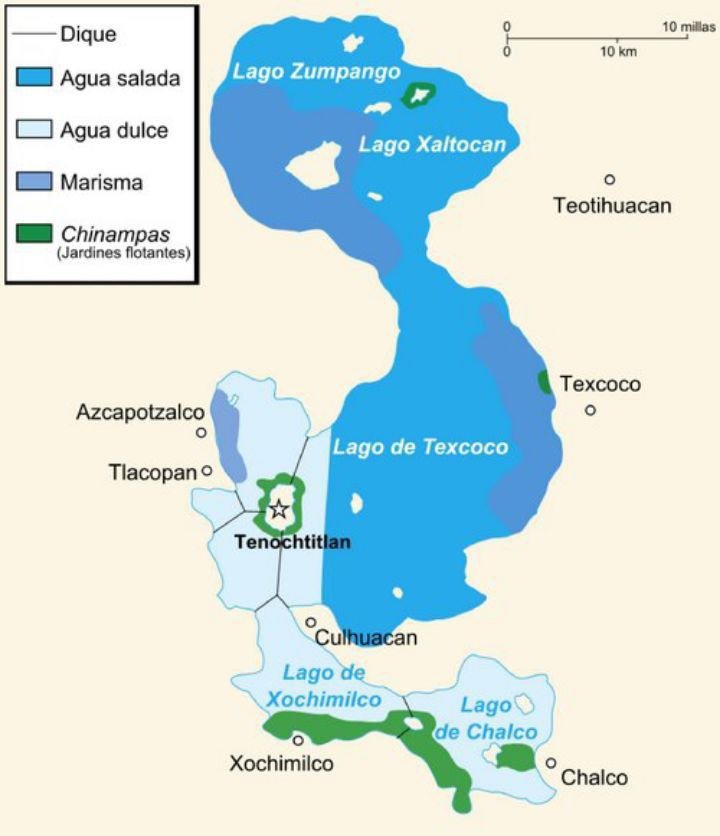
Axolotl is native to the two lakes of the Mexican valley named Lake Xochimilco and Lake Chalco. The freshwater of these lakes was the main reason why these creatures thrive there. The certain water temperature(that rarely goes above 20 degrees celsius)of these lakes allowed them to live along with salamanders(another creature that is almost similar to axolotl.).
However, now Lake Chalco does not exist due to human intervention, even the cleanliness of Lake Xochimilco got affected due to which their numbers are decreasing. Axolotls are still bought by people from corners of the world to increase the grace of their aquariums, but as aquariums can’t provide an atmosphere like lakes of Mexico, Axolotls lack some features.
Appearance: Axolotls special body features
An adult axolotl of 17-27 months old generally has a body length from 15 to 45 cm, however, a length greater than 30cm is rare. Axolotls very much look like salamander larvae. The feather-like gills in them come out from their head. The three gills behind the head are used to move in water, four gills while hidden behind external gills that make particles filter through.
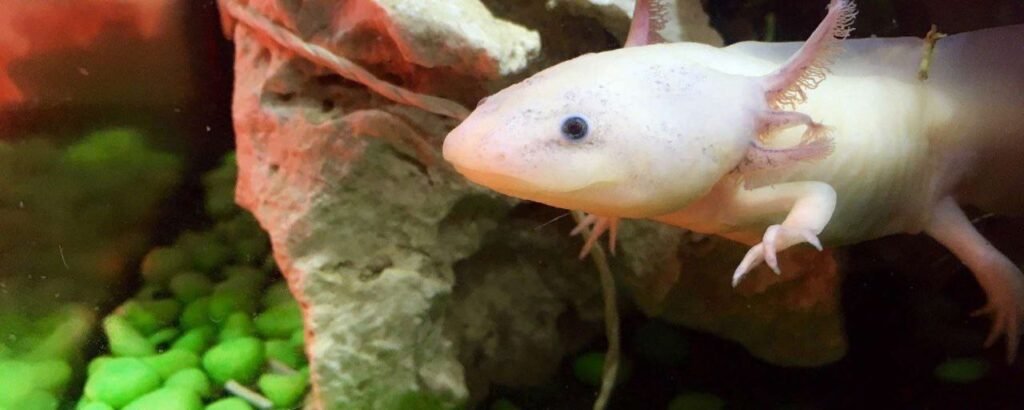
Salamanders lose their external gills when matured into adulthood but Axolotls on the other side keep this feature, as they are more aquatic and have neoteny evolution than salamanders. They have webbed feet, a dorsal wing along their body, round and dark lidless eyes on their wide head, undeveloped teeth, and a tail. Their mouths often bend into a quirky, grin smile as they grow. Axolotls are of various colors right from grey, brown shades to golden albino. Their webbed feet allowed them to move at 15 km per hour. Out of male axolotls, females are easily identifiable through their wide body full of eggs.
Diet: What Axolotls eat
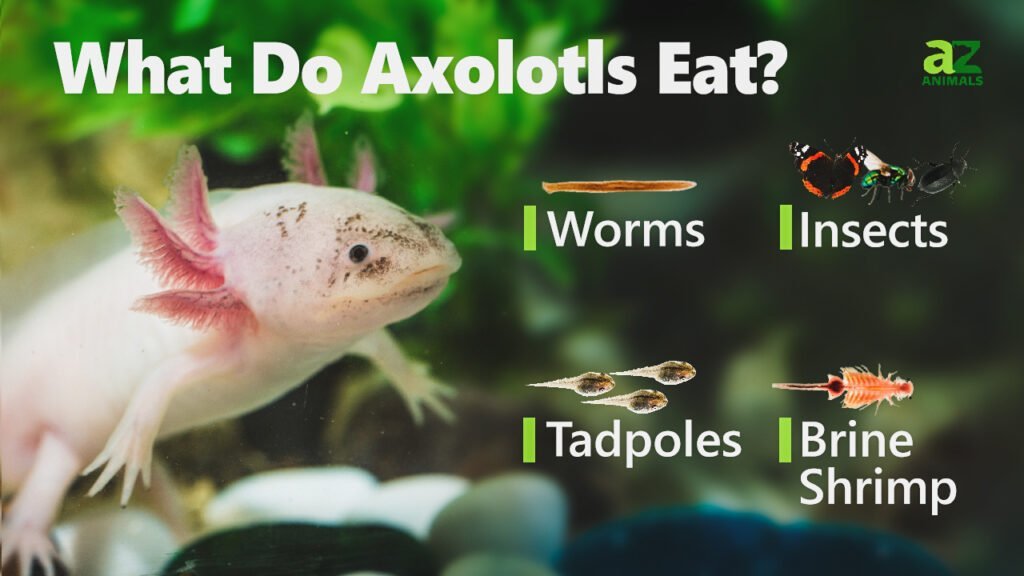
Axolotls in the daytime burrow into the mud from being eaten by predators like big fishes, storks, herons and at night they become hungry and eat inhaling worms, tadpoles, insects, small fish, insect larvae through the suction mechanism. Gills allow them to breathe in water but they pop up over the surface to take gulps of air timely. The juvenile Axolotls grow faster if it’s having a diet of bloodworm, Daphnia as it gives them proper nutrition.
Family life: How do Axolotls reproduce?
Sexual maturity is required to reproduce but that’s not the case with Axolotls. They can give birth to young ones during their larval stage without undergoing metamorphosis (this phenomenon is called neoteny ), which makes them different from amphibians. The mating of males and females begins with rubbing and sliding on each other’s cloaca(cavity at the end of the digestive tract to release genital products in case of vertebrates) while moving circularly. After around half a minute of strong tail waving, the male drops sperm, and the female collects it with her cloaca, this begins fertilization.
This process happens between 6-12 months of age and starts in the mid-hot season when water temperatures are gentle. Their small gills and tails grow from their head side enabling them to stick to the substrate during hatching. Gills and legs size increase as they get older.
Axolotl superpowers
Regeneration is the part of life for a few organisms like in the case of invertebrates (not having backbones). In the case of vertebrates like humans, regeneration is limited to growing skin or scar tissue, but we can’t grow limbs, organs if they get damaged. Frogs are vertebrates that can regenerate but lose their ability once they turn fully into adults. While axolotls an amazing vertebrate can regenerate throughout their life not only body organs but even brain cells, neurons.
Their study can unlock such hidden potential in humans. Here’s how.
Process of regeneration in Axolotls
Axolotls can grow any of their lost organs. The way axolotls regrow their limbs begins with the limb’s surviving cells. Once a limb is lost, the blood clot instantly stops bleeding, just similar to what happens in humans. But after some days, cells beneath the epidermis start dividing and forming a cone-shaped structure called a blastema(also called regeneration bud).
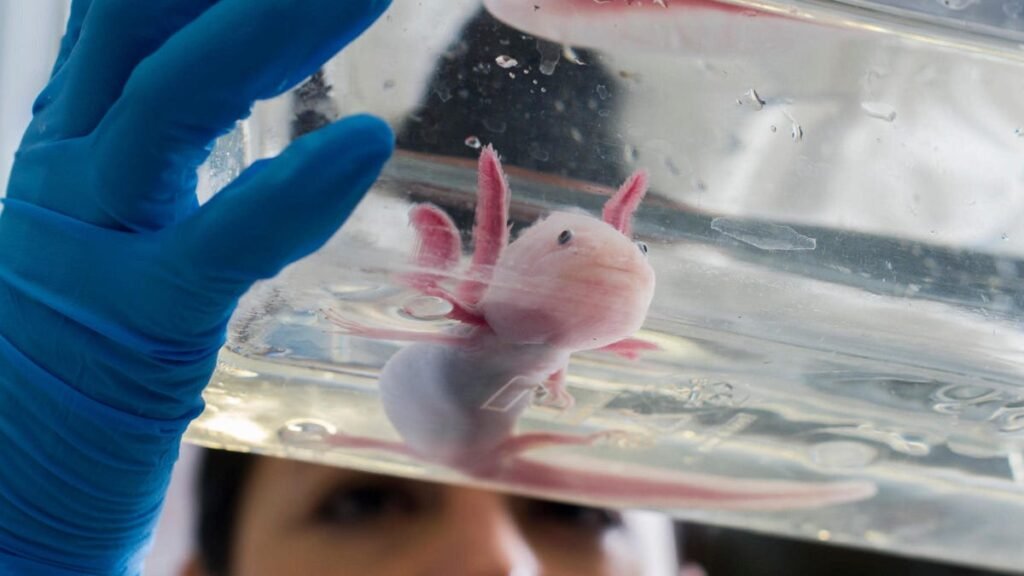
It is the area where bone, cartilage, muscle cells lose their identity and transform into stem cells. Those transformed cells then slowly regenerate the bone, skin, veins just like what stem cells do when animals are first developing in their egg. During the cells dividing in the blastema, nerves and blood vessels connect it to the rest of the body.
Axolotls can regrow parts of the brain
In the case of vertebrates like humans, neurons and brain cells grow only till the embryonic stage. Any neurogenesis in adulthood is very much limited. If brain damage in adulthood occurs, then the brain can’t generate new neurons, blood vessels, or tissues. But Axolotls has no problem doing all this. Axolotls by de-differentiate their stem cells can create new neurons throughout their life, even spinal cord and different parts of the brain after an injury. The salamander is the only four-legged vertebrate that can transform regular cells back into stem cells thus allowing them again to develop into new tissue.
How can Axolotls superpowers benefit us?
Axolotls don’t have special genes or hormones for such a superpower, they just regulate their genes differently from other animals in the whole process. Due to this scientists are hopeful that we humans still have this ability locked in us and once it’s unlocked can benefit humanity. The exact mechanism of how axolotl de-differentiates their cells is still not known, but some main components are starting to be unveiled and astonishingly many of them resemble just like cells and molecules in humans’ bodies. The way to learn what molecules and cells are important in axolotls to regenerate is to look for molecular changes that cause them to lose this ability.
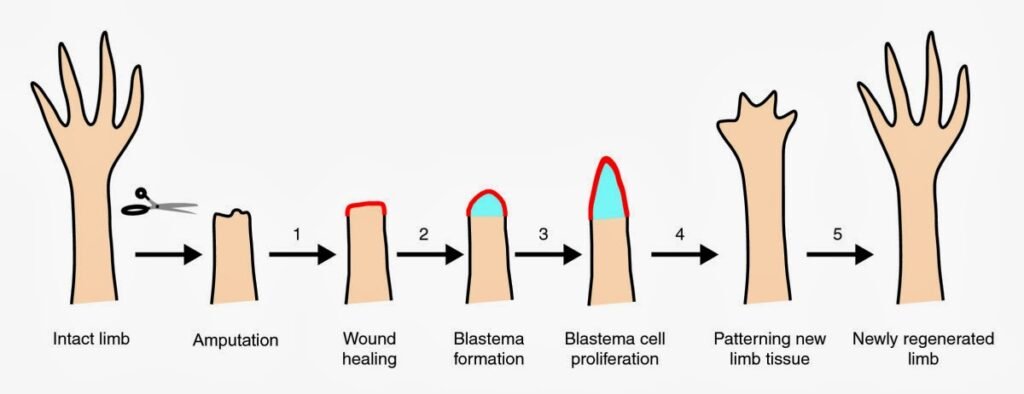
Like macrophage is a cell of the immune system and has its importance during inflammation is previously connected to regeneration. Researchers once injected a drug in axolotls before amputation that eliminates macrophages in the body and it has been found that instead of regeneration scar tissue formed there. This showed macrophage typical cells humans also have are important in regeneration.
One protein called transforming growth factor-beta is important in preventing scar tissue and healing wounds in humans and also has its necessary role in axolotl regeneration. Another research said that mice and humans can regenerate partially disfigured or cut finger or toe, however, humans lose this ability as they grow. Researchers believed that a type of stem cell near our fingernails could be the residue from that time when our regeneration abilities were stronger.
Axolotls allow humans to get such astonishing results by studying them more but here the problem lies THEIR EXTINCTION.
How Extinction of Axolotls is emerging?

A 1998 survey’s data showed that around 6000 axolotls were living per square km in their habitat while in 2015 the number decreased to only 35 axolotls per square km area. It was predicted that axolotls will go extinct by 2020 but they somehow managed to escape from their destiny. Their number is not exactly known but it is decreasing. Right now, naturally, axolotls can only be found in Lake Xochimilco which at present, is just a series of small canals.
It is just 2 percent of the original massive wetland as increased population and changing climate drained all lakes except Lake Xochimilco. The pollution of this lake will soon evict Axolotls from there. Axolotls can thrive well in labs and aquariums but they lack their generic diversity that wards off disease.
Scientists planned to give them a new home. One such place figured by them near the National Autonomous University of Mexico where a freshwater lake emerged from an abandoned quarry. Many axolotls were released there. It is a different place from swampy canals where they grow but it is right now the best option for the long-term survival of this amazing creature.

1 Comment
Pingback: Axolotl: jedinečný živočích s regeneračnými schopnosťami » UnitedLife